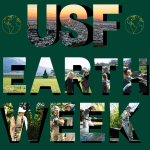Professor Allison Luengen, an expert in marine sciences that focuses her studies on the cycling and bioavailability of trace metals, took this spring semester’s MSEM Marine Resources class out into the field to experience firsthand the vast biodiversity of marine organisms. From minuscule to massive, plankton to elephant seals, students got to have hands on (or a safe viewing distance) experience with some of California’s coastal species! As a student who took this course, here’s everything I loved about it…
Class outside is always a win in my book especially when we’re all a part of MSEM to come up with management practices to help protect our environment. Out of the four Saturday classes, two were spent enjoying the breathtaking views of Northern California while getting up close and personal with some of the smallest and largest species found along our coast. Our first trip was down at the Greater Farallones National Marine Sanctuary, a beautiful research center that overlooks the Golden Gate Bridge. After reading, writing, and discussing all things plankton we got to collect samples and try to identify species under the microscopes. From diatoms to larvaceans, and many in-between we observed how each one was individually shaped and their locomotive techniques (the way they would move). I loved hanging out with my classmates (which are really just my friends at this point) by getting to know each other more and discussing everyone’s interests. Like how some of my classmates are avid birders that were trying to identify each of the birds that were hanging out at the beach with us and some of the others that are into photography – trying to get the perfect shot of the day.
Our second class trip was a gorgeous coastal drive down highway 1 to Año Nuevo Reserve, a protected area packed with elephant seals. In the week leading up to the trip, we studied how methylmercury biomagnifies in top trophic species and when elephant seals molt their pelage (fur and skin) it is packed with mercury that releases back into the marine environment – which continued a vicious cycle of methylmercury in the ecosystem. To see these huge blubbery mammals was an incredible experience. Everyone in my class, including myself, was shocked by how close we were allowed to get to the elephant seals. They would often be hanging out on the trails we walked along which allowed us to really understand just how big they are. Also, hearing their strange, but distinct grunts was a whole new experience for me. At Año Nuevo, as you look out from the beach, you can see a small island once inhabited by lighthouse keepers that helped warn ships to avoid crashing into the shoreline. The house is now decrepit and falling over, but some of the seals don’t seem to mind! The Año Nuevo Docent recalled a story of a California sea lion being found in the upstairs bathtub! The reserve is also unique in that it’s home to many other species like birds, snakes, and small mammals. In fact, if you’re lucky enough, the endangered California Garter Snake can be seen slithering in and out of the brush.
At the end of the trip a few of my classmates and I stopped off at Pie Ranch to wrap up this already wonderful day with local produce and a delicious walnut pie.
If you’re considering joining the MSEM program, or have a passion for the ecosystems off the California coast, then I would highly recommend taking this course if you get the chance!





